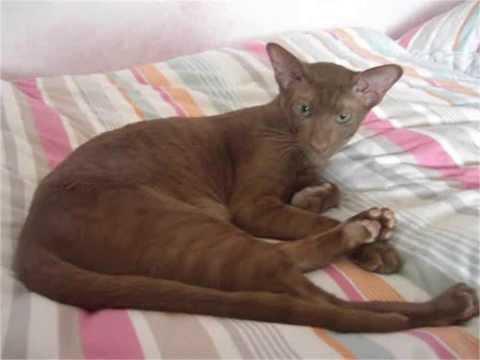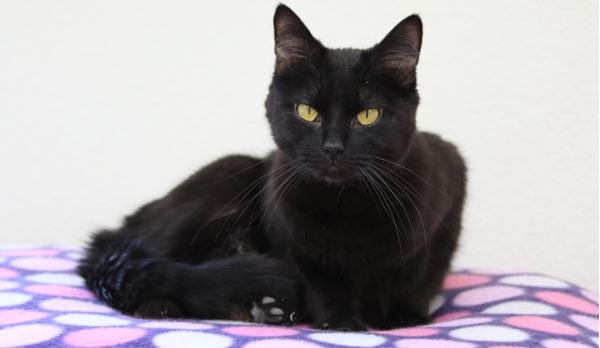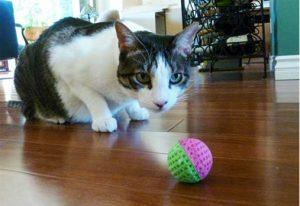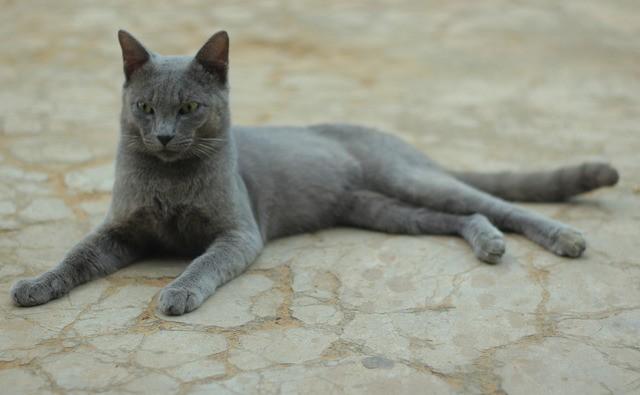Raas Cat
The Raas cat is a breed of elegant felines that evolved in Indonesia. It has physical characteristics very similar to a jungle cat, or a leopard. These cats have a graceful look with a size larger than most of the other cat breeds in general. The face of the raas is a little squarish shape. They have dark green eyes with an oval shape that are not too wide. The shape of the skull is roundish, with the chin being slightly tapered, while the ears are erect, pointy and long. Compared to most of the other common breeds, the tail of these cats is conspicuously long with a slightly bent edge.
Quick Description
Physical Appearance & Size
| Length (size): | Medium |
Colors & Patterns
| Coat Type: | Short, smooth, soft |
| Coat Color Patterns: | Pattern of plain solid color primarily with two coat colors viz., blue to gray (more common), and chocolate. Brown appears rarely |
Other Characteristics
| Personality Traits: | Loyal, active, intelligent, playful |
| Hypoallergenic: | Unknown |
| Country of Origin: | Indonesia |
History and Development
The Raas cat is a breed of domestic cats that evolved in Madura in the Raas Island of Indonesia. They are so primitive that, there have been innumerous local myths and tales about them, one of which is very strange. It says that these felines have a sixth sense, and can only be maintained by a certain group of people like clerics, officials, and community leaders.
Another myth tells a different story. It says, if these cats are taken away to the other islands (other than the Raas Island) by a boat piloted by unmarried people, the boat will sink. In addition to these myths, people also believed that, if the Raas cat is taken out of the island of Raas , the people who carry it will get bad luck.
Raas is a cat whose beginning is unknown. But these are a very pure and original breed devoid of genes mixed from other breeds, yet, have a high genetic variation. Most likely the cat is formed naturally. According to the Australian feline expert Lasley Morgan, the Raas cats, especially those with a prominent bluish hue, have originated from the race Korat, the famous breed that is extensively spread across Thailand.
Some sources have also mentioned that, these cats have originated from the Asian race, which is evitable from the shape of its tail, since its bent tail tip is a trait common to many Asian breeds of cats.
Temperament and Personality
Raas are cats are energetic and playful, but are apparently afraid of humans, and sometimes find it difficult to adapt themselves. But once they get tamed, you will surely fall in love with them all over again, when they stare at you with their kind, mesmerizing eyes. But, unlike most other cats, these cats do not want to work just for the sake of pleasing their owners. So, irrespective of the fact that how much they are appreciated for their ‘good jobs’, it will not really motivate them. On the contrary, it is the responsibility of the owners to search for ways of motivating them.
Training the raas would need some innovation and loads of patience, since they might show stubborn and grumpy attitude at times. These cats, with a primitive modality, are basically moody, and hence, it is almost impossible to affirm that the methods that worked earlier for these cats will also work now.
Since the raas cats had initially been bred for the purpose of hunting vermin, it is now considered a domestic cat with a primitive streak after years of domestication. It would be wise for the owners to train this cat with all patience. It is also advisable not to apply the training methods of dogs on these felids, since it would not be very much successful.
Care
Groom them at least once or twice weekly by brushing their coats with a soft brush. This is important in order to retain the natural gloss of their typical dark colored coat. You should also brush their teeth to ward of possibilities of common feline dental issues like tartar buildup. Trim their nails when they outgrow the size of their paws.
With a playful, zealous demeanor, these cats need lots of exercise for a healthy living. Keep them free all day and let them play all day all around your house and remain active, making sure, they do not get a chance to move out of your house. However, you can also take them out for a daily walk. However, a leash is recommended when you take them outdoors, which is for their wild, rustic nature. Without a leash you might lose control over your raas, since their instinct might easily prompt them to get lost in the wild while, chasing some rodents or vermins.
Begin your training sessions like litter, leash and obedience, as early as possible, while it’s still young. But never pamper your kitten giving in to its demands, since this might eventually lead to serious behavior issues. Be in command over your cat, but never be rude during training, since it would only end in creating a distance between you and your raas.
Because they have an inherent wild instinct, it would be effective if you would generously allow them to play games with cat toys, and involve them in learning to fetch and retrieving tricks. Running behind their favorite objects would be something they would cherish, since such tricks would act much better in keeping them active, rather than formal training sessions. This would not only keep them happy, but would also entice them to actively participate in activities, and at the same time, would take care of their need for daily exercise.




